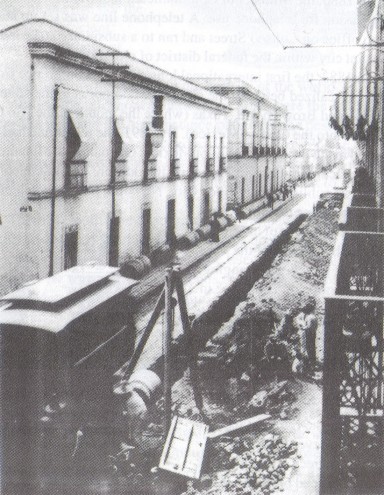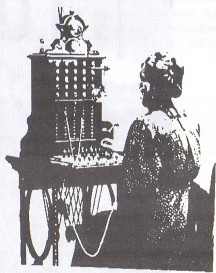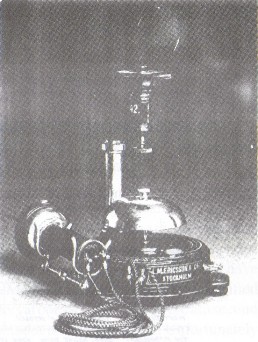Avatares Del Telefono En Mexico
by David Benedict
Reprinted from "Crown Jewels of the Wire", December 1993, page 25
The following is the first of a series of articles on the origin and use of
the telephone in Mexico. The articles are the result of the translation of
information acquired from the book entitled Avatares del Telefono en Mexico by
Fatima Fernandez Christlieb. The book was copyrighted by Teleindustria Ericsson,
S.A. de C.V. I would like to acknowledge and extend my appreciation to Sr. Jorge
Arredondo, Director of Corporate Relations, Teleindustria Ericsson for providing
me a copy of the manuscript and other contemporary research materials, including
an annual Report of Operations. I would also like to extend a heartfelt thank
you to Mrs. Celia Arredondo (no relation to Sr. Jorge Arredondo) for her
diligent efforts in translating the manuscript.
Part 1 : The Origin of the Telephone in Mexico City

Laying of ducts for underground cables in the center of Mexico City in 1908.
The technological revolution of the 19th century transformed the lives of
people throughout the world. Transportation, communication, and improvement in
the standard of living were realized through such innovations as the iron horse,
steam boat, electric lights, the phonograph, and the telephone. The far
distances of our planet became within a hand's reach. Of all the inventions, the
telephone had enormous repercussions; one of them, without a doubt, consists of
facilitating live voice communication across various distances.
When Alexander
Graham Bell conducted research on helping deaf people hear, it is quite probable
that he did not imagine that the outcome of his persistence would bring about
the telephone or the transmission of sound through conducting wires.
Nevertheless, by 1876, his experiment soared from invention to a revolution in
communication.
In 1880, the Minister of Communication of Mexico granted the
first concession for telephone use. A telephone line was set up at a telegraph
office on Coliseo Street and ran to a subsidiary at Tlelpan, the most distant
city within the federal district of old Mexico City.
In 1883, the first
international long distance conference from Mexico was realized between the
cities of Matamoros in the state of Tamaulipas and Brownsville, Texas (where the
mouth of the Rio Grande River opens into the Gulf of Mexico). By 1891, the
telephone had been established in the following cities of Mexico: Guadalajara,
Matamoros, Puebla, Oaxaca, Merida, and Veracruz. In addition, the first
telephone directory was published in Mexico City. No doubt that early telephone
directory, and those that followed, provided not only a list of individual
subscribers, but a view of the emergence of a modem, changing Mexico. The price
of a new line in 1891 was six pesos and a quarter (peseta) a month for lines of
a kilometer or less in length. Installation was ten pesos.
The first directory
says something very quaint: "Every subscriber has the right to talk with
all others whenever he wants and with utmost secrecy", which could be
certain if instead of mentioning the name of the person one would say his
number. It was also advertised that the telephone office would stay open every day including Sundays and
holidays.

Operator with manual switchboard
Many illustrious subscribers appeared in the first directory including Jose
Ives Lumantour, House Minister; Ignacios Mariscal, of Relations; the capitalist
Gabriel Mancera; and Pedro Santacilia, son-in-law of Benito Juarez. It is
interesting that Don Portirio Diaz does not appear on the list, nor the surnames
of the ancient conservators, but those of businessmen and liberals, in general,
people more permeable to the novelty of the world.

Among the telephones that
existed there were the long distance phone for the wall and the long distance
phone for the desks (at the right, circa 1881), which was nickel plated and
movable from place to place. There was also a revolving long distance phone for
the desk, stuck to the edge of the desk by a rectangular tube which permitted it
to revolve to all sides of the desk.
There were different services. One was
called "Land Circuits ("Circuito de Tierra")" and was
composed of one line from the house of the subscriber to the electric switch at
the telephone central. The circuit was complete by grounding the two ends of the
line. The other service was called "Metallic Circuits ("Circuito
Metalico")" which was a system that employed two lines instead of one,
and was not grounded.
By 1901, the number of doctors with telephones were almost
fifty and there were no less than six public telephones installed in Mexico
City. The public telephones could be found at two different grocery stores, a
drug store, the post office, the railroad station, and a local bar known as
"la cantina de Quintana". I wonder which phone was most often in use.
The phone at the railroad station, right?? A modest fee was paid to use the
public telephone. The actual amount was not disclosed in the text.
By 1928,
fifty years after the establishment of the Mexican Telephone Company, the manual
telephone exchange was replaced with automatic public telephones. The calls cost
five cents (cinco centavos). Ericsson Company was the number one telephone company with over 700 employees
including operators and laborers. The Ericsson was in competition with the
Mexican Telephone Company. The price for telephone calls would depend on the
distance of the call, and the company providing the service. Calls from Mexico
City to Ensenada, Baja California cost twenty pesos.
A call from Mexico City to
Guadalajara would be more or less four pesos.
| 